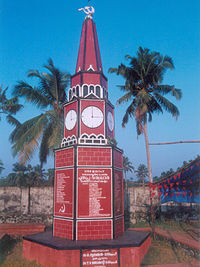Punnapra-Vayalar uprising
| Punnapra-Vayalar Uprising | |||||||
|---|---|---|---|---|---|---|---|
| Part of Communist Movements in Travancore against the Diwan | |||||||
 Memorial of Punnapra-Vayalar uprising martyrs located near Kalarcode, Alappuzha |
|||||||
|
|||||||
| Belligerents | |||||||
|
|
Laborers in Punnapra and Vayalar |
||||||
| Commanders and leaders | |||||||
| K. Kelappan | T. V. Thomas | ||||||
| Casualties and losses | |||||||
| Minor deaths | More than 1,000 people dead (Unconfirmed) | ||||||
The Punnapra-Vayalar uprising (October, 1946) was a communist uprising in the Princely State of Travancore, British India against the Prime Minister, C. P. Ramaswami Iyer and the state. Communist Party members were killed by the army of the Diwan (Prime Minister), 200 people at Punnapra on 24 October and more than 150 at Vayalar on 27 October. The total loss of life is allegedly estimated to be more than a thousand.
Historians like Prof Sreedhara Menon (though one website claimed that he had retracted his views later) maintain this was a proper struggle against the declaration of 'Independent Travancore' by the then Travancore government. The interpretation of this incident is still debated. Some people suggest certain Communist leaders instigated the coir workers belonging to the Ezhava community to wage a war against the then administration led by C. P. Ramaswami Iyer. T K Varghese Vaidya, a leader of the struggle, had gone on record saying it was a rehearsal for a larger revolution with the ultimate objective of establishing a "Communist India".
The region around Alleppey was a Communist stronghold and the communist workers organised a mass upheaval in October 1946 against the authority of the Diwan, and practically established their own government in the region. This led to attacks and deaths of Travancore police officials and government officials in that region. Dismayed by the turn of events, the Diwan declared martial law in Alleppy on 25 October 1946. The Travancore army moved from their camp and surrounded the communists at Vayalar by 27 October. The Travancore navy supported the army in isolating Vayalar, which is surrounded by water on three sides. Once the blockade was in place, the army moved in. It is estimated that at least 150 people were killed on the spot during the army's pincer movement on 27 October, and many more succumbed to injuries later. On the same day, at least 130 people were killed in army firings, elsewhere in the district. The local people and press maintain that many more people were killed and the bodies disposed by the army. Historians like A. Sreedhara Menon estimates that over a thousand people were killed during the Punnapra-Vayalar outbreak. Atrocities were not one sided, and there are reports of murders of Travancore policemen after they had surrendered to the communists, during the early stages of the disturbances. Police Inspector Velayudhan Nadar had moved forward to reason out with the communists, but he was brutally stabbed to death. This hardened the stance of the police and the armed forces. Following the suppression of the communist local governments, the Travancore police used heavy-handed methods to repress the political movement in the region and detained many activists without any trial.
...
Wikipedia
